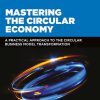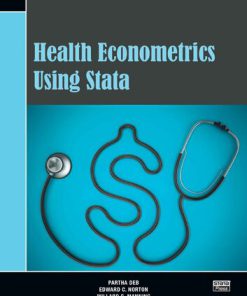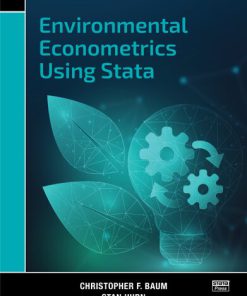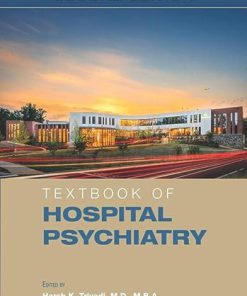Microeconometrics Using Stata 2nd Edition by Pravin K Trivedi, A Colin Cameron ISBN 159718361X 9781597183611
$50.00 Original price was: $50.00.$25.00Current price is: $25.00.
Microeconometrics Using Stata 2nd Edition by Pravin K Trivedi, A Colin Cameron – Ebook PDF Instant Download/Delivery: 159718361X ,9781597183611
Full download Microeconometrics Using Stata 2nd Edition after payment

Product details:
ISBN 10: 159718361X
ISBN 13: 9781597183611
Author: Pravin K Trivedi, A Colin Cameron
Microeconometrics Using Stata 2nd Edition Table of contents:
1 Stata basics
1.1 Interactive use
1.2 Documentation
1.3 Command syntax and operators
1.4 Do-files and log files
1.5 Scalars and matrices
1.6 Using results from Stata commands
1.7 Global and local macros
1.8 Looping commands
1.9 Mata and Python in Stata
1.10 Some useful commands
1.11 Template do-file
1.12 Community-contributed commands
1.13 Additional resources
1.14 Exercises
2 Data management and graphics
2.1 Introduction
2.2 Types of data
2.3 Inputting data
2.4 Data management
2.5 Manipulating datasets
2.6 Graphical display of data
2.7 Additional resources
2.8 Exercises
3 Linear regression basics
3.1 Introduction
3.2 Data and data summary
3.3 Transformation of data before regression
3.4 Linear regression
3.5 Basic regression analysis
3.6 Specification analysis
3.7 Specification tests
3.8 Sampling weights
3.9 OLS using Mata
3.10 Additional resources
3.11 Exercises
4 Linear regression extensions
4.1 Introduction
4.2 In-sample prediction
4.3 Out-of-sample prediction
4.4 Predictive margins
4.5 Marginal effects
4.6 Regression decomposition analysis
4.7 Shapley decomposition of relative regressor importance
4.8 Difference-in-differences estimators
4.9 Additional resources
4.10 Exercises
5 Simulation
5.1 Introduction
5.2 Pseudorandom-number generators
5.3 Distribution of the sample mean
5.4 Pseudorandom-number generators: Further details
5.5 Computing integrals
5.6 Simulation for regression: Introduction
5.7 Additional resources
5.8 Exercises
6 Linear regression with correlated errors
6.1 Introduction
6.2 Generalized least-squares and FGLS regression
6.3 Modeling heteroskedastic data
6.4 OLS for clustered data
6.5 FGLS estimators for clustered data
6.6 Fixed-effects estimator for clustered data
6.7 Linear mixed models for clustered data
6.8 Systems of linear regressions
6.9 Survey data: Weighting, clustering, and stratification
6.10 Additional resources
6.11 Exercises
7 Linear instrumental-variables regression
7.1 Introduction
7.2 Simultaneous equations model
7.3 Instrumental-variables regression
7.4 Instrumental-variables example
7.5 Weak instruments
7.6 Diagnostics and tests for weak instruments
7.7 Inference with weak instruments
7.8 Finite sample inference with weak instruments
7.9 Other estimators
7.10 Three-stage least-squares systems estimation
7.11 Additional resources
7.12 Exercises
8 Linear panel-data models: Basics
8.1 Introduction
8.2 Panel-data methods overview
8.3 Summary of panel data
8.4 Pooled or population-averaged estimators
8.5 Fixed-effects or within estimator
8.6 Between estimator
8.7 Random-effects estimator
8.8 Comparison of estimators
8.9 First-difference estimator
8.10 Panel-data management
8.11 Additional resources
8.12 Exercises
9 Linear panel-data models: Extensions
9.1 Introduction
9.2 Panel instrumental-variables estimation
9.3 Hausman–Taylor estimator
9.4 Arellano–Bond estimator
9.5 Long panels
9.6 Additional resources
9.7 Exercises
10 Introduction to nonlinear regression
10.1 Introduction
10.2 Binary outcome models
10.3 Probit model
10.4 MEs and coefficient interpretation
10.5 Logit model
10.6 Nonlinear least squares
10.7 Other nonlinear estimators
10.8 Additional resources
10.9 Exercises
11 Tests of hypotheses and model specification
11.1 Introduction
11.2 Critical values and p-values
11.3 Wald tests and confidence intervals
11.4 Likelihood-ratio tests
11.5 Lagrange multiplier test (or score test)
11.6 Multiple testing
11.7 Test size and power
11.8 The power onemean command for multiple regression
11.9 Specification tests
11.10 Permutation tests and randomization tests
11.11 Additional resources
11.12 Exercises
12 Bootstrap methods
12.1 Introduction
12.2 Bootstrap methods
12.3 Bootstrap pairs using the vce(bootstrap) option
12.4 Bootstrap pairs using the bootstrap command
12.5 Percentile-t bootstraps with asymptotic refinement
12.6 Wild bootstrap with asymptotic refinement
12.7 Bootstrap pairs using bsample and simulate
12.8 Alternative resampling schemes
12.9 The jackknife
12.10 Additional resources
12.11 Exercises
13 Nonlinear regression methods
13.1 Introduction
13.2 Nonlinear example: Doctor visits
13.3 Nonlinear regression methods
13.4 Different estimates of the VCE
13.5 Prediction
13.6 Predictive margins
13.7 Marginal effects
13.8 Model diagnostics
13.9 Clustered data
13.10 Additional resources
13.11 Exercises
14 Flexible regression: Finite mixtures and nonparametric
14.1 Introduction
14.2 Models based on finite mixtures
14.3 FMM example: Earnings of doctors
14.4 Global polynomials
14.5 Regression splines
14.6 Nonparametric regression
14.7 Partially parametric regression
14.8 Additional resources
14.9 Exercises
15 Quantile regression
15.1 Introduction
15.2 Conditional quantile regression
15.3 CQR for medical expenditures data
15.4 CQR for generated heteroskedastic data
15.5 Quantile treatment effects for a binary treatment
15.6 Additional resources
15.7 Exercises
A Programming in Stata
A.1 Stata matrix commands
A.2 Programs
A.3 Program debugging
A.4 Additional resources
B Mata
B.1 How to run Mata
B.2 Mata matrix commands
B.3 Programming in Mata
B.4 Additional resources
C Optimization in Mata
C.1 Mata moptimize() function
C.2 Mata optimize() function
C.3 Additional resources
Glossary of abbreviations
References
Author index
People also search for Microeconometrics Using Stata 2nd Edition:
microeconometrics using stata revised edition pdf
microeconometrics using stata
microeconometrics with stata
what statistical test to use for cross sectional study
what is a cross sectional study statistics
Tags: Pravin K Trivedi, A Colin Cameron, Microeconometrics, Stata
You may also like…
Medicine - Anatomy and physiology Medicine - Veterinary Medicine
Uncategorized
Functional Estimation for Density Regression Models and Processes 2nd Edition Odile Pons
Uncategorized
Uncategorized
Medicine - Psychiatry
Textbook of Hospital Psychiatry 2nd Edition Harsh K. Trivedi
Business & Economics - Econometrics
ECONOMETRIC MODELS WITH PANEL DATA APPLICATIONS WITH STATA 1st Edition César Pérez López
Business & Economics - Mathematical Economics
Medicine - Epidemiology
Epidemics: Models and Data Using R 2nd Edition by Ottar 9783031120558 3031120558











